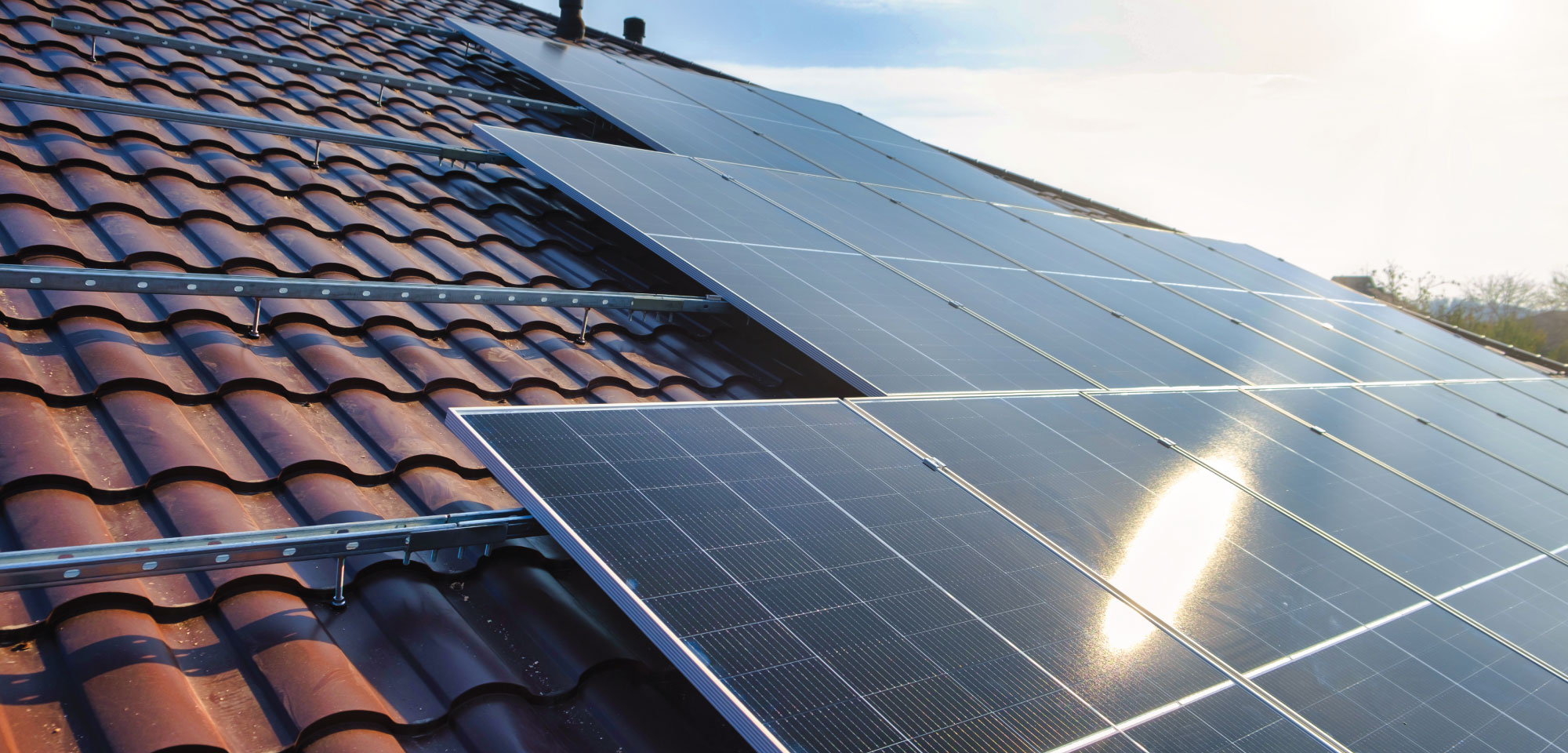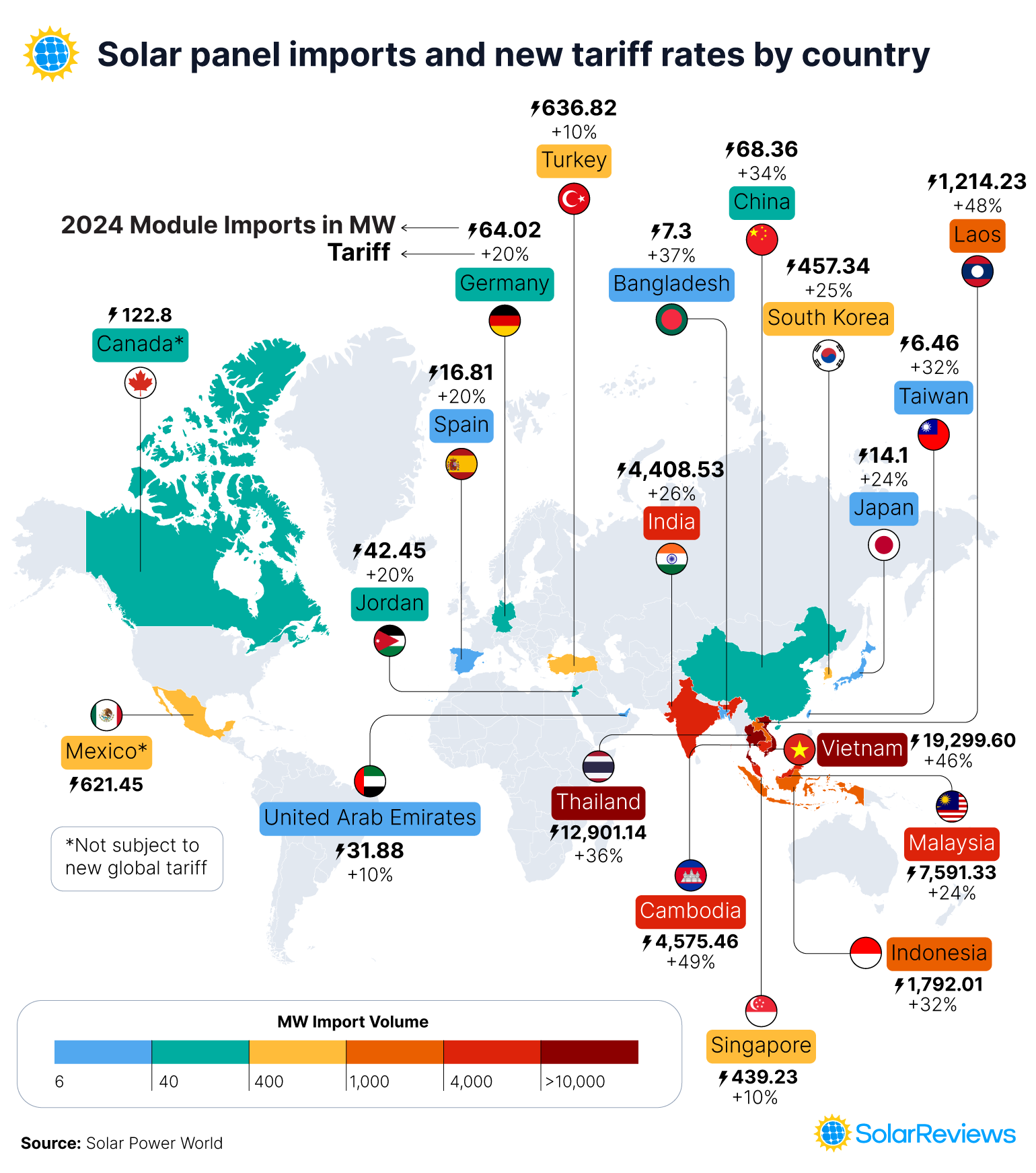Updated 8 months ago
Trump Tariffs Impact on Solar: Increased Prices and Potential Fraud
Written by
Catherine Lane

Find out what solar panels cost in your area
On April 9, 2025, President Donald Trump announced a 90-day pause on reciprocal tariffs and reverting back to the 10% tariff rate for all countries except for China. Chinese imports are subject to 145% reciprocal tariffs. The article below describes the tariffs announced on April 2, 2025.
The Trump Administration’s new sweeping tariffs could cause uncertainty for the solar industry, which relies heavily on imported goods. In our 2025 Solar Industry Survey, 56% of solar installation companies cited concern about potential tariffs, and these fears are being realized.
The United States imported nearly 48.5 GW of solar modules in the first three-quarters of 2024 alone, and many domestically manufactured panels rely on imported components, like solar cells and aluminum.
There is no question that these new “Liberation Day” tariffs will impact the price of going solar, and some bad actors may use this as an opportunity to take advantage of homeowners looking to go solar by inflating prices even further. Here’s what you need to know about Trump’s tariffs and how to protect yourself from solar companies looking to take advantage of an uncertain situation.
A history of tariffs and the solar industry
.png)
The solar industry is no stranger to tariffs on imported products. The first tariffs levied on solar panels came in 2012 when the Commerce Department under President Obama initiated tariffs of between 24% and 36% on solar panels from China.
The panels in question were being produced with significant subsidies from the Chinese government, then sold in the United States below the cost to produce them, a practice known as “dumping.” The tariffs were designed to protect solar manufacturers operating in America from having to compete with ultra-cheap foreign products.
Despite these tariffs, solar manufacturers still struggled to produce panels in the United States at prices that could compete with Chinese products, and many Chinese manufacturers simply moved their operations to countries where the U.S. had no such tariffs.
In 2018, President Trump added several new tariffs on products from a much broader list of countries. These included the Section 201 tariffs on imported crystalline solar cells, which were extended in 2022 by the Biden Administration, and Section 232 tariffs on almost all aluminum and steel imports.
These tariffs did prompt some manufacturers to set up shop in America, but simultaneously, they made business more difficult for solar installation companies who relied on a stream of low-cost panels for their business. An analysis by the Solar Energy Industries Association found the tariffs ultimately cost the industry 62,000 American jobs and increased installation costs for homeowners.
New reciprocal tariffs hit major countries for solar imports
The United States relies heavily on solar imports from Southeast Asia, an area that has been hit particularly hard by the new tariffs. Vietnam and Cambodia are not only two of the top five countries for U.S. solar imports, but they are also among the countries hit with the highest “Liberation Day” tariffs, with 46% and 49% tariffs, respectively.

Displays tariff rates announced on April 2, 2025.
American-made solar panels aren’t coming out of this unscathed, either. Although the modules are manufactured domestically, many rely on imported components, like silicon solar cells and metals. Malaysia, South Korea, and Thailand account for the majority of solar cell imports, all of which have been slapped with tariffs of over 20%.
Country | MW of solar cell imports (2024) | New tariff |
|---|---|---|
Malaysia | 4411.54 | 24% |
South Korea | 4187.46 | 25% |
Thailand | 2728.26 | 36% |
Laos | 778.25 | 48% |
India | 267.17 | 26% |
Cambodia | 148.6 | 49% |
Indonesia | 144.5 | 32% |
Germany | 99.99 | 20% |
Taiwan | 87.22 | 32% |
Singapore | 19.11 | 10% |
Sources: Solar Power World; The White House
Will Trump’s new tariffs increase home solar prices?
The slew of new tariffs will lead to higher solar equipment costs. However, there is a silver lining. Solar equipment accounts for roughly 41% of the total cost of a home solar installation, with the bulk of expenses tied to installation, soft costs, permitting and design, and profit margins.
When you just consider the 46% tariffs on imports from Vietnam — the country from which the U.S. imports the most solar panels — the cost of a solar installation rises from $3.03 per watt to about $3.28 per watt. This doesn’t include the impact tariffs could have on other equipment, like inverters.
While price increases aren’t ideal, even the highest tariff increases passed on to consumers should only extend payback periods moderately. Increasing electric rates can help soften the blow, too, with hikes of 20% on the horizon in states like New Jersey.
How the tariffs can increase solar fraud
Tariffs have been all over the news lately, stirring panic over the cost of living and confusion about how exactly they work.
Unfortunately, some bad actors across industries will jump on this opportunity to increase their pricing substantially, even when they don’t have to. We saw a similar situation during COVID-19 when companies hiked prices, citing pandemic-related supply chain disruptions to increase their profits.
Some solar companies may exploit the confusion surrounding tariffs as a chance to inflate their prices, profiting off of unsuspecting homeowners. While price increases may be justified, it's important to remain cautious of excessively high quotes.
4 ways to stay protected against tariff impacts
Solar shoppers have many reasons to be cautious, including so-called “solar bros”— door-to-door salespeople who use high-pressure tactics (even allegedly falsifying signatures on loan documents) to get a homeowner to sign up for overly expensive solar installations.
With the potential for price-gouging disguised as tariff-related increases — coupled with the Trump Administration’s push to gut federal government offices and weaken the Federal Consumer Protection Bureau (one of the few resources for homeowners dealing with bad companies) — it's more important than ever for homeowners to protect themselves.
1. Plan ahead
If you’re serious about going solar, it’s better to do it sooner rather than later. That said, don’t allow yourself to be pressured into a deal, and don’t always believe a salesperson who tells you that the price will increase if you don’t sign today.
However, tariffs are a key component of Trump’s economic plan, and there is a possibility that they’ll be here to stay, or even increase, as countries retaliate in escalating trade conflicts.
It’s also important to note that the President hasn’t always been an advocate for solar. Despite buddying up to clean energy CEO Elon Musk and claiming he’s “a big fan of solar,” his energy policy plans are devoid of renewables, and his closest energy advisors are fossil fuel advocates.
There have already been attempts to repeal portions of the Inflation Reduction Act, which contains important tax credits to offset the cost of installing solar panels. If you’re interested in solar power to save money, start looking now and be ready if you find a good deal.
2. American-made products
Another way to mitigate the impact of tariffs on your solar investment is by looking for solar products manufactured in the United States. There are plenty of major solar manufacturers assembling panels in the U.S. that make high-quality products that might be less impacted by the tariffs.
It is important to note that while plenty of solar panels are manufactured in the United States, many of the components used are imported from other countries, meaning they won’t be fully protected from the tariffs. The United States imports a large amount of solar cells from Malaysia, which is now subject to a 24% tariff, potentially increasing the cost of a solar panel made with Malaysian cells by 18%. However, this can still be cheaper than purchasing foreign-made panels.
3. Read customer reviews carefully
Customer reviews can indicate what kind of solar company you’re dealing with, and it’s important to look at them with a critical eye to ensure you’re working with a trustworthy company.
Even if you find an installer with recent positive reviews, be sure to read some of the negative ones. Homeowners can have an excellent initial experience with their installers but receive subpar service down the line.
Keep that in mind as you read reviews and see if any patterns emerge in the types of positive and negative reviews a company receives.
4. Shop around for solar installers
The best way to protect yourself from being overcharged for solar is to get quotes from multiple companies. Comparing solar quotes allows you to see what more than one company is charging in your area. Extremely high prices will be obvious compared to reliable companies’ quotes.
Shopping around also gives you the opportunity to speak to multiple installers. Ask them if they expect tariffs to impact their pricing, or if they already have, and what you can expect from them in the future.
Catherine has been researching and reporting on the solar industry for five years and is the Written Content Manager at SolarReviews. She leads a dynamic team in producing informative and engaging content on residential solar to help homeowners make informed decisions about investing in solar panels. Catherine’s expertise has garnered attention from leading industry publications, with her work being featured in Solar Today Magazine and Solar ...
Learn more about Catherine Lane